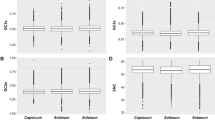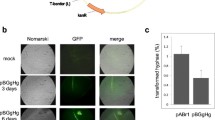Abstract
The potentials and limitations of negative-selection systems based on the human herpes simplex virus thymidine kinase type-1 (HSVtk) gene, which causes sensitivity to the nucleoside analog ganciclovir, were examined in tobacco as a model system. There were great differences between individual HSVtk+ transgenic plants in ganciclovir sensitivity. Inhibition of growth while under selection correlated with HSVtk-tianscnpt levels. Negative selection against HSVtk+ transformants at the level of Agrobacterium-mediated transformation using a ganciclo-vir/kanamycin double-selection medium (the positive selection marker neomycin phosphotransferase-II gene was in the transformation vector) resulted in a three- to six-fold reduction in the frequency of kanamycin-resistant shoots. The efficiency of negative selection in this case was limited due to the great variation in HSVtk expression, i.e., the frequently occurring transformants with low, or no, ganciclovir sensitivity escaping negative selection. Two independently constructed HSVtk genes showed the same variability of the phenotype in Nicotiana tabacum transformants. Distinct phenotypes, ranging from no regeneration through abnormal or delayed regeneration, were observed when leaf segments were placed on shoot-inducing medium supplemented with 10−6−10−3 M ganciclovir. The highest HSVtk mRNA and ganciclovir sensitivity levels were observed in plants which were transformed with the pSLJ882 chimeric construct. The pSLJ882 plant expression vector carried the coding sequence of HSVtk, whereas plasmid pCX305.1 carried an HSVtk construct retaining the untranslated 5 leader and viral 3 regions. The pCX305.1 transformants showed, at most, a delayed formation of shoots with thin stems and very narrow leaves. Ganciclovir sensitivity showed typical Mendelian segregation. A gene-dosage effect was also seen at the seedling level in the progeny of two transgenic lines.
Similar content being viewed by others
References
An G (1987) Binary Ti vectors for plant transformation and promoter analysis. Methods Enzymol 153:292–305
An G, Ebert PR, Mitra A, Ha S-B (1988) Binary Vectors. In Gelvin SB. Schilperoort RA (eds) Plant molecular biology manual. Kluwer Academic Publishers, Dordrecht, pp A3:l–19
Capecchi MR (1989) Altering the genome by homologous recombination. Science 244:1288–1292
Czakó M, An G (1991) Expression of DNA coding for diphtheria toxin chain a is toxic to plant cells. Plant Physiol 95:687–692
Czakó M, Márton L (1994) The herpes simplex virus thymidine kinase gene as a conditional negative-selection-marker gene in Arabidopsis thaliana. Plant Physiol 104:1067–1071
Czakó M, Jang J-C, Herr JM, Jr, Márion L (1992) Differential manifestation of seed mortality induced by seed-specific expression of the diphtheria toxin chain ‘A’ gene in Arabidopsis and tobacco. Mol Gen Genet 235:33–40
Depicker AG, Jacobs AM, Van Montagu MC (1988) A negative-selection scheme for tobacco protoplast-derived cells expressing the T-DNA gene 2. Plant Cell Rep 7:63–66
Hilson P, Dewulf J, Delporte F, Installe P, Jacquemin P-M, Jacobs M, Negrutiu I (1990) Yeast RAS2 affects cell viability, mitotic division and transient gene expression in Nicotiana species. Plant Mol Biol 14:669–685
Hunt AG, MacDonald MH (1989) Deletion analysis of the polyadenylation signal of a pea ribulose-1,5-bisphosphate carboxylase small-subunit gene. Pl Mol Biol 13:125–138
Jones JDG, Shlumukov L, Carland F, English J, Scofield SR, Bishop GJ, Harrison K (1992) Effective vectors for transformation, expression of heterologous genes, and assaying transposon excision in transgenic plants. Transgen Res 1:285–297
Karlin-Neumann GA, Brusslan JA, Tobin EM (1991) Phytochrome control of the tms2 gene in transgenic Arabidopsis: a strategy for selecting mutants in the signal transduction pathway. Plant Cell 3:573–582
Kunkel TA (1985) Rapid and efficient site-specific mutagenesis without phenotypic selection. Proc Natl Acad Sci USA 82:488–492
Koltunow AM, Truettner J, Cox KH, Wallroth M, Goldberg RB (1990) Different temporal and spatial gene-expression patterns occur during anther development. Plant Cell 2:1201–1224
Koning A, Jones A, Fillatti JJ, Comai L, Lassner MW (1992) Arrest of embryo development in Brassica napus mediated by modified Pseudomonas aeruginosa exotoxin A. Pl Mol Biol 18:247–258
Maiti IB, Murphy JF, Shaw JG, Hunt AG (1993) Plants that express a potyvirus proteinase gene are resistant to virus infection. Proc Natl Acad Sci USA 90:6110–6114
Mansour SL, Thomas KR, Capecchi MR (1988) Disruption of the proto-oncogene int-2 in mouse embryo-derived stem cells: a general strategy for targeting mutations to non-selectable genes. Nature 336:348–352
Mariani C, De Beuckeleer M, Truettner J, Leemans J, Goldberg RB (1990) Induction of male sterility in plants by a chimeric ribonuclease gene. Nature 347:737–741
Márton L, Wullems GJ, Molendijk L, Schilperoort RA (1979) In vitro transformation of cultured cells from Nicotiana tabacum by Agrobacterium tumefaciens. Nature 277:129–131
McKnight SL, Gavis ER, Kingsbury R (1981) Analysis of transcriptional regulatory signals of the HSV thymidine kinase gene: identification of an upstream control region. Cell 25:385–398
Mogen BD, MacDonald MH, Graybosch R, Hunt AG (1990) Upstream sequences other than AAUAAA are required for efficient messenger RNA 3′-end formation in plants. Plant Cell 2:1261–1272
Perera RJ, Linard CG, Signer ER (1993) Cytosine deaminase as a negative selective marker for Arabidopsis. Pl Mol Biol 23:793–799
Renckens S, De Greve H, Van Montagu M, Hernalsteens JP (1992) Petunia plants escape from negative selection against a transgene by silencing the foreign DNA via methylation. Mol Gen Genet 233:53–64
Schardl CL, Byrd AD, Benzion G, Altschuler MA, Hildebrand DF, Hunt AG (1987) Design and construction of a versatile system for the expression of foreign genes in plants. Gene 61:1–11
Stougaard J (1993) Substrate-dependent negative selection in plants using a bacterial cytosine deaminase gene. Plant J 3:755–761
Thorsness MK, Kandasamy MK, Nasrallah ME, Nasrallah JB (1991) A Brassica S-locus gene promoter targets toxic gene expression and cell death to the pistil and pollen of transgenic Nicotiana. Dev Biol 143:173–184
Widholm JM, Kishinami I (1988) Allyl alcohol-selection for lower alcohol dehydrogenase activity in Nicotiana plumbaginifolia cultured cells. Plant Physiol 86:266–269
Xiang C. Guerra DJ (1993) The anti-nptII gene. Plant Physiol 102:287–293
Author information
Authors and Affiliations
Additional information
Communicated by Y. Gleba
Rights and permissions
About this article
Cite this article
Czakó, M., Marathe, R.P., Xiang, C. et al. Variable expression of the herpes simplex virus thymidine kinase gene in Nicotiana tabacum affects negative selection. Theoret. Appl. Genetics 91, 1242–1247 (1995). https://doi.org/10.1007/BF00220935
Received:
Accepted:
Issue Date:
DOI: https://doi.org/10.1007/BF00220935




